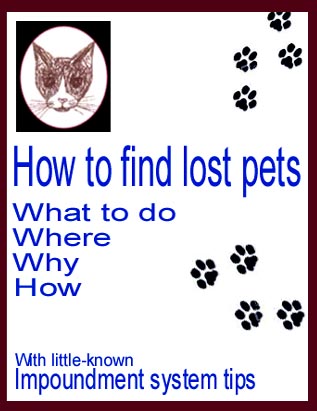
. .
.
If you do 10 things to find your lost pet, what are the consequences if you should have done 30?
Because you
are likely most-anxious to get started, NOTE:
5. How to limit your search labor
Click to continue How to Search - Section IV-b ....
Popular pet products: 2004, Copyright cT2, inc., Box 7164,
If you find a broken link, please email . Thank you!
LOST PETS
Who -- What
IV-a.
Applicable to any U.S. area --
Applicable to some International areas
II.
Where lost pets go; animal behaviors; statistics; problems
III.
IV.
How to search for a lost pet - Section IV-a
![]() You are here
You are here
Section IV-b
Section IV-c Section IV-d
Section IV tips:
Be sure to read all pages of Section IV.
There are many
comments within comments that could be
tells you why a search map is
vital; Section IV-c covers intake lists
and the issues of human error;
Section IV-d covers tips on sound recognition.
V.
VI.
Our information has been carefully checked many
times, from many angles; however, laws change, facilities change,
numbers change, situations change.
We encourage you to verify verify verify.
In this 4-page section:
A
Note:
Some information in this report is difficult to cope with and not for
the faint of heart; plan for an efficient search; it can take weeks or
months to find the lost.
Although this document is written
mostly in reference to dogs and cats, the principles can be applied to
other critters as well. Use your best judgment regarding your particular
lost pet and conduct your search accordingly.
printer friendly page
for all of Section IV How to Search for lost Pets
we have included a list of things you
can do to find your pet.
> > > > > > >
However,
because the devil is in the details,
please also read all of the
information below as soon as possible.
This is page IV-a;
return to top to click on additional Section IV links,
or go to bottom and continue to page
IV-b
A. SEARCH
BASICS
Read all info posted on this website.
See Section
V when you're ready to simplify your search schedule.
1. Overwhelming
Details? Important: Do not let these details overwhelm you. First, read through all info. Keep
an open mind. Get a solid understanding of the wide area around where
your pet was lost. If, for example, you live in a city of 300,000
people, you will likely have other cities nearby as well as suburbs. Minneapolis,
Minnesota has over 300,000 people; the greater-metro area
has over 3 million people in about 176 separate municipalities in our
immediate 7-county metro area, all within reasonable distance for search
efforts. This document will give you details on how to
accomplish necessary search tasks in your own area, whether a large, complex
urban area, or rural community.
2. Tough But Not
Impossible. The efforts required to find a lost pet make worrying about that lost
pet just that much more painful. Still, finding the lost is not
impossible. There are many things you can do to find your
pet, and most can be done with a modicum of effort.
3. Other Pets. In the meantime, if you have additional pets still at home, be
sure to keep them lovingly confined, and provide them with proper
current identification. A collar with tags, plus an implanted chip are
recommended. Also keep a good, clear photo of each pet, showing the
entire body, not just a face shot.
This report, then, will attempt to describe these details for you, so
that you might make your best effort to get a lost pet back home.
First, it is suggested that you simply and quickly read through
Reminder 1: Pounds and shelters are required to keep animals only 5 days,
although
some keep them longer.
Reminder 2: Veterinarians have confirmed that even a small pet can
travel indefinitely at 3 miles per hour, so that in 8 hours, your pet could
travel 24 miles. Even so, some pets,
especially cats -- and also those pets lost away from home -- tend to
stay in the area as long as they possibly can waiting and hoping to be
found.
Reminder 3: Some pets can be found quickly, others may take weeks
or months to surface. It is important to not give up too soon.
a. Plan well.
As you begin your search, you can limit much long-term labor by planning
well. Things you can do that will make your search easier down the road include:
b. Keep excellent records. Keep good, controllable lists of places to
contact, with their phone numbers, addresses, and email addresses, as well as
names of persons you have spoken with. Also keep short notes about your
discussions with them.
c. Poster supplies. From the moment you start your search, carry a
goodly supply of posters and bulletin-board cards with you so you
can post them immediately whenever needed; as you see posters have been
taken down or bulletin boards have been cleared, repost them. If you
make a habit of carrying a card or poster or two with you when you go to
a grocery store or elsewhere, you won't have to run back to your vehicle
or home
to get one. Continued below ....
Poster tips:
1) There are many sites on the web
for automatic poster-making. Simply search "lost pet poster" to find
them.
2)
Take a few minutes to search through various sites to find your best
poster example and method.
3) Once you have your poster made up, print it on 11x17"
posterboard or cardstock at your local copier center, print shop, office
supply store, etc. (they should be able to enlarge it from 8-1/2 x 11"
up to 11x17" for you)
4)
For outdoor postings, if you cannot
afford lamination to protect the poster long-term, tape clear plastic
over the entire poster, front and back, with no leakage areas.
5) Indoor posters of smaller size may be adequate.
Bulletin Board cards. Visit your local grocery
store and ask for a supply of bulletin board cards. Six or eight should
do. Take the cards home and write your lost pet information on each one.
Paste these up on a sheet of printer paper, two across, totaling the six
or eight cards on one sheet. Then visit your copier center and make
plenty of copies on cardstock. Cut them apart for bulletin board
postings.
d. Email. If you use a computer (as opposed to reading this from
a printed copy), first of all, email everybody you know with information
about your lost pet. Set your email up in poster fashion with your
complete contact info. Ask everyone to email everyone they know.
Hopefully, this will set in motion a "viral" email campaign designed to
get the maximum number of people looking for your lost pet (this may not
work in some circumstances, depending on animal, species, area, etc).
As people email you, keep their email addresses in an email mailing
list. Also keep a list of email addresses of facilities and businesses you can contact by email on a regular basis.
As you visit agencies, ask for their email address to
add to your list, and ask them to add your email address to their email
address book to ensure any email you send them down the road will be
received.
If you
have a good bulk email program available, that can be most helpful. Then
once a month or so, send a reminder email to everyone on your list, and ask them
to make sure your poster is still on their bulletin board, if appropriate, or
simply let them know you are still looking. You may also set up an email
notification, whereby you will be notified if your email is opened by
the recipient. An unopened email could mean your email got caught in
their spam filter.
Set your email up similar to
a poster, with a photo of your pet included (keep in mind that some
security program setups will not allow your photo to be received,
however, so your email should be designed around that problem and should
include a clear description of the lost pet).
e. Plan your visits with or without email. Once you have a good, workable email list in order, then you can determine who is
not emailable. Those which you cannot send email info and
reminders to are the facilities to call or visit, instead.
Section IV continued ... see "Click to continue" link below![]()
Reminder
Plan to start collecting names, phone numbers, addresses, email addresses, website
addresses, and chat locations online right at the beginning of your search. With
no computer, an alphabetical cardfile with one card per agency in one
section and one card per important contact person in a separate section
can be helpful to keep everything in easily-accessible order.
Edible Supplies
Online Catalogs
Cleaning and D.O.
Minneapolis, Mn 55407
All rights reserved
Questions or comments,
.
Additional keywords: animal pound animal shelter dog pound
impoundment facility county pound city pound
humane society spca humane shelter neighborhood search
police pound sheriff department animal control spca humane society
lost pet blog lost pets blog
I've lost my pet; now what?
Help me find my lost pet?
What if my pet gets lost?
Where can I find lost pet rescue?
Study this site carefully;
one little detail may be the one that brings
your lost pet home.
and has the in-depth info you need.
Here you'll find information on what happens to pets in pounds,
how animals are killed (euthanized) in pounds and shelters,
how to find out what happens to animals in pounds,
as well as how to find lost cats and
how to find lost dogs.
This website lost pets info is now available in book form:

Book pricing here
Popular
Pet Products:
Pet Training
Edible Supplies
Online Catalogs
Cleaning
and D.O.
List of
Where to search:
Animal pounds
Animal shelters
Humane Society Shelters
No-Kill Shelters
Catteries
Kennels
City Offices
Police facilities
Police Departments
Sheriff facilities
Sheriff Offices
Veterinary facilities
Also:
Highway Departments
Sanitation Departments
Also:
Breed Assoc.
Groomers
Pet Shops
Research labs
Trainers
Leave posters with all
Other areas to check:
Lost and Found listings
Pets For Sale Listings
Bulletin boards
Craig's List online
Found posters
Breeder wanted ads
Other things to do:
Create email campaign
Offer a reward
Put up posters
Place Lost ads
List on Bulletin Boards
Post on Craig's List
Human interest articles
Contact TV news
Contact Radio News
Get on chat sites online
Recruit wide-area helpers
At home/neighborhood:
Keep shelter available
Keep food/water out
Keep on visiting area
Search area regularly
Call pet's name often
If cat located, live trap
Doorknock & leave info
Recruit neighbor help
Recruit kids
Keep on looking, for
days, weeks, months
Printer-friendly list

Check here for animal-
related collectibles
at notarynut.com
monkey business
You can limit much long-term labor by planning well.
and save in
your Favorites)
send feedback
l
hopefulness
Windows Quick Find
(mouse over)
l
pet
info articles
pet products
nature products
find all your pounds
all shelters
all no-kill shelters
reasons
- where
other issues
Please help
support this site
--any amount--
so we may continue
helping
get lost pets home
Thank you!
Dirt Dog robot

Your efforts will pay off.
Keep your lost pet search going while studying this website's information.
Back to top
Back to top
Back to top
Back to top
Back to top
Back to top